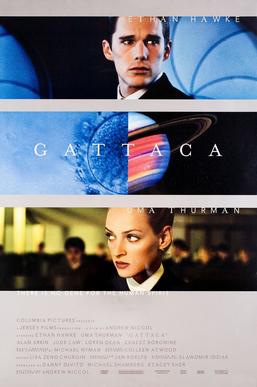
Eugenics is a set of beliefs and practices that aim to improve the genetic quality of a human population. Historically, eugenicists have attempted to alter human gene pools by excluding people and groups judged to be inferior or promoting those judged to be superior. In recent years, the term has seen a revival in bioethical discussions on the usage of new technologies such as CRISPR and genetic screening, with heated debate around whether these technologies should be considered eugenics or not.

William Bradford Shockley Jr. was an American inventor, physicist, and eugenicist. He was the manager of a research group at Bell Labs that included John Bardeen and Walter Brattain. The three scientists were jointly awarded the 1956 Nobel Prize in Physics for "their researches on semiconductors and their discovery of the transistor effect".

Gattaca is a 1997 American dystopian science fiction drama thriller film written and directed by Andrew Niccol in his directorial debut. It stars Ethan Hawke and Uma Thurman with Jude Law, Loren Dean, Ernest Borgnine, Gore Vidal, and Alan Arkin appearing in supporting roles. The film presents a biopunk vision of a future society driven by eugenics where potential children are conceived through genetic selection to ensure they possess the best hereditary traits of their parents. The film centers on Vincent Freeman, played by Hawke, who was conceived outside the eugenics program and struggles to overcome genetic discrimination to realize his dream of going into space.

A cloaking device is a hypothetical or fictional stealth technology that can cause objects, such as spaceships or individuals, to be partially or wholly invisible to parts of the electromagnetic (EM) spectrum. Fictional cloaking devices have been used as plot devices in various media for many years.

Determinism is the philosophical view that events are completely determined by previously existing causes. Deterministic theories throughout the history of philosophy have developed from diverse and sometimes overlapping motives and considerations. Like eternalism, determinism focuses on particular events rather than the future as a concept. The opposite of determinism is indeterminism, or the view that events are not deterministically caused but rather occur due to chance. Determinism is often contrasted with free will, although some philosophers claim that the two are compatible.
Biological determinism, also known as genetic determinism, is the belief that human behaviour is directly controlled by an individual's genes or some component of their physiology, generally at the expense of the role of the environment, whether in embryonic development or in learning. Genetic reductionism is a similar concept, but it is distinct from genetic determinism in that the former refers to the level of understanding, while the latter refers to the supposedly causal role of genes. Biological determinism has been associated with movements in science and society including eugenics, scientific racism, and the debates around the heritability of IQ, the basis of sexual orientation, and sociobiology.

Hermann Joseph Muller was an American geneticist, educator, and Nobel laureate best known for his work on the physiological and genetic effects of radiation (mutagenesis), as well as his outspoken political beliefs. Muller frequently warned of long-term dangers of radioactive fallout from nuclear war and nuclear testing, which resulted in greater public scrutiny of these practices.

Popular science is an interpretation of science intended for a general audience. While science journalism focuses on recent scientific developments, popular science is more broad ranging. It may be written by professional science journalists or by scientists themselves. It is presented in many forms, including books, film and television documentaries, magazine articles, and web pages.

Cold Spring Harbor Laboratory (CSHL) is a private, non-profit institution with research programs focusing on cancer, neuroscience, plant biology, genomics, and quantitative biology.

Solar Crisis is a 1990 Japanese-American co-production science fiction thriller film directed by Richard C. Sarafian. The screenplay was written by Joe Gannon and Tedi Sarafian, based on the 1990 novel Crisis 2050 by Takeshi Kawata, who co-produced the film. The film was first released in Japan in 1990, and in the United States in 1992.
Brett Leonard is an American film director, producer and music video director specializing in the science fiction and horror genres. A few of his films such as The Lawnmower Man (1992) and Virtuosity (1995) feature groundbreaking computer animation and visual effects. The Lawnmower Man is considered the first, seminal film to feature "virtual reality" as a cautionary tale becoming the number one commercially successful independent film of 1992, budgeted at just under $6 million and eventually earning over $150 million worldwide.

Mundane science fiction (MSF) is a niche literary movement within science fiction that developed in the early 2000s, with principles codified by the "Mundane Manifesto" in 2004, signed by author Geoff Ryman and "The Clarion West 2004 Class". The movement proposes "mundane science fiction" as its own subgenre of science fiction, typically characterized by its setting on Earth or within the Solar System; a lack of interstellar travel, intergalactic travel or human contact with extraterrestrials; and a believable use of technology and science as it exists at the time the story is written or a plausible extension of existing technology. There is debate over the boundaries of MSF and over which works can be considered canonical. Rudy Rucker has noted MSF's similarities to hard science fiction and Ritch Calvin has pointed out MSF's similarities to cyberpunk. Some commentators have identified science fiction films and television series which embody the MSF ethos of near-future realism.

Tech-noir is a hybrid genre of fiction, particularly film, combining film noir and science fiction, epitomized by Ridley Scott's Blade Runner (1982) and James Cameron's The Terminator (1984). The tech-noir presents "technology as a destructive and dystopian force that threatens every aspect of our reality".

The Science & Entertainment Exchange is a program run and developed by the United States National Academy of Sciences (NAS) to increase public awareness, knowledge, and understanding of science and advanced science technology through its representation in television, film, and other media. It serves as a pro-science movement with the main goal of re-cultivating how science and scientists truly are in order to rid the public of false perceptions on these topics. The Exchange provides entertainment industry professionals with access to credible and knowledgeable scientists and engineers who help to encourage and create effective representations of science and scientists in the media, whether it be on television, in films, plays, etc. The Exchange also helps the science community understand the needs and requirements of the entertainment industry, while making sure science is conveyed in a correct and positive manner to the target audience.
Michael B. Elowitz is a biologist and professor of Biology, Bioengineering, and Applied Physics at the California Institute of Technology, and investigator at the Howard Hughes Medical Institute. In 2007 he was the recipient of the Genius grant, better known as the MacArthur Fellows Program for the design of a synthetic gene regulatory network, the Repressilator, which helped initiate the field of synthetic biology. He was the first to show how inherently random effects, or 'noise', in gene expression could be detected and quantified in living cells, leading to a growing recognition of the many roles that noise plays in living cells. His work in Synthetic Biology and Noise represent two foundations of the field of Systems Biology. Since then, his laboratory has contributed to the development of synthetic biological circuits that perform a range of functions inside cells, and revealed biological circuit design principles underlying epigenetic memory, cell fate control, cell-cell communication, and multicellular behaviors.
Design fiction is a design practice aiming at exploring and criticising possible futures by creating speculative, and often provocative, scenarios narrated through designed artifacts. It is a way to facilitate and foster debates, as explained by futurist Scott Smith: "... design fiction as a communication and social object creates interactions and dialogues around futures that were missing before. It helps make it real enough for people that you can have a meaningful conversation with".
Xiaoxing Xi is a Chinese-born American physicist. He is the Laura H. Carnell Professor and former chair at the Physics Department of Temple University in Philadelphia. In May 2015, the United States Department of Justice arrested him on charges of having sent restricted American technology to China. All charges against him were dropped in September 2015.

Aspects of genetics including mutation, hybridisation, cloning, genetic engineering, and eugenics have appeared in fiction since the 19th century.

Biology appears in fiction, especially but not only in science fiction, both in the shape of real aspects of the science, used as themes or plot devices, and in the form of fictional elements, whether fictional extensions or applications of biological theory, or through the invention of fictional organisms. Major aspects of biology found in fiction include evolution, disease, genetics, physiology, parasitism and symbiosis (mutualism), ethology, and ecology.
A Dangerous Idea: Eugenics, Genetics and the American Dream is a 2016 documentary film about genetics, eugenics, and social inequality in the United States. The film was directed by Stephanie Welch and distributed exclusively by Bullfrog Films.













